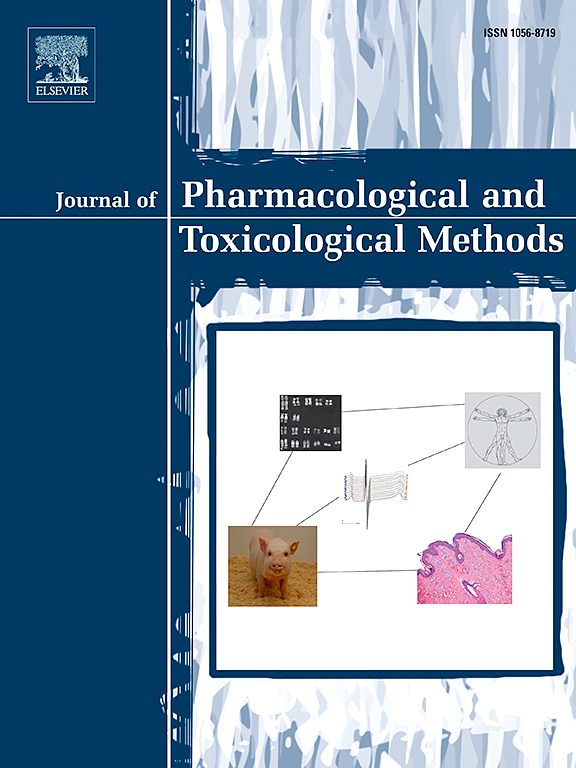State-of-the-art in secondary pharmacology and its impact on the safety of new medicines
IF 1.3
4区 医学
Q4 PHARMACOLOGY & PHARMACY
Journal of pharmacological and toxicological methods
Pub Date : 2025-05-01
DOI:10.1016/j.vascn.2025.107680
引用次数: 0
Abstract
Adverse effects of drugs often result from unexpected drug-off-target interactions triggering secondary pharmacology (2P). Consequently, 2P profiling of new chemical entities across a range of protein targets is a routine task in pharmaceutical R&D. Particularly targets with known association to safety adverse events (e.g., GPCRs, ion channels, transporters, protein kinases and other enzymes) are considered. However, there is significant variability across pharmaceutical industry in the composition of target panels screened, assay technologies implemented, and in the timing and scheduling of 2P screening efforts. As part of the IQ DruSafe consortium, a 2P working group was established, comprising representatives from 18 companies, to conduct a review of 2P strategies and share experiences, to recommend best practices and future application for the industry. Member companies contributed proprietary data across parameters such as target panel composition, position in the R&D process, sourcing of the panels, the assay types and technology used. Performance and outcome, including total number of compounds run, concentrations tested, and hit rates, were also recorded. A detailed database capturing an overview of the strategic, scientific, and operational aspects of 2P screening has been created accordingly. This database currently holds 3729 records detailing on assays covering 747 distinct biological targets that are assessed for 2P. Conclusions will be presented highlighting some key trends that should be considered for future evolution of 2P practices across the industry. The working group identified a strong influence of previous published work on 2P panel composition by Bowes et al. 2012 and Lynch et al., 2017 with high prevalence of the targets they propose applied across the industry, but also a set of uncommon targets has been identified that should be considered from a safety perspective. Furthermore, given the recent broadening in pharmaceutical targets by precision medicine approaches, extending the coverage of 2P previously under-represented target classes such as protein kinases, enzyme families and epigenetic targets appears to be important.
Bowes et al. 2012, Bowes, J., Brown, A. J., Hamon, J., Jarolimek, W., Sridhar, A., Waldron, G., & Whitebread, S. (2012). Reducing safety-related drug attrition: The use of in vitro pharmacological profiling. Nature Reviews: Drug Discovery, 11(12), 909–922.
Lynch, J. J., Vleet, T. R. V., Mittelstadt, S. W., & Blomme, A. G. (2017). Potential functional and pathological side effects related to off-target pharmacological activity. Journal of Pharmacological and Toxicological Methods, 87, 108–126.
二级药理学的最新进展及其对新药安全性的影响
药物的不良反应通常是由于意想不到的药物-脱靶相互作用引发继发性药理学(2P)。因此,在一系列蛋白质靶点上对新化学实体进行2P分析是药物研发中的一项常规任务。特别是已知与安全不良事件相关的靶点(例如,gpcr,离子通道,转运体,蛋白激酶和其他酶)被考虑。然而,整个制药行业在筛选靶板的组成、实施的测定技术以及2P筛选工作的时间和安排方面存在显著差异。作为IQ DruSafe联盟的一部分,成立了一个2P工作组,由来自18家公司的代表组成,负责审查2P战略并分享经验,为行业推荐最佳实践和未来应用。成员公司提供了各种参数的专有数据,如靶板组成、研发过程中的位置、板的来源、检测类型和使用的技术。还记录了性能和结果,包括运行的化合物总数、测试的浓度和命中率。因此,建立了一个详细的数据库,概述了2P筛查的战略、科学和操作方面的情况。该数据库目前拥有3729条详细记录,涵盖了评估2P的747个不同生物靶点。报告的结论将强调在整个行业2P实践的未来发展中应该考虑的一些关键趋势。工作组确定了Bowes等人(2012年)和Lynch等人(2017年)对2P面板组成的先前发表的工作的强烈影响,他们提出的目标在整个行业中应用的普遍性很高,但也确定了一组应从安全角度考虑的不常见目标。此外,鉴于最近通过精确医学方法扩大了药物靶点,扩大以前未被充分代表的2P靶点类别(如蛋白激酶、酶家族和表观遗传靶点)的覆盖范围似乎很重要。Bowes et al. 2012, Bowes, J., Brown, A., Hamon, J., Jarolimek, W., Sridhar, A., Waldron, G., &;白面包,S.(2012)。减少与安全性相关的药物损耗:体外药理学分析的使用。自然评论:药物发现,11(12),909-922。Lynch, j.j., Vleet, t.r.v., Mittelstadt, s.w., &;Blomme, a.g.(2017)。与脱靶药理活性相关的潜在功能和病理副作用。中国生物医学工程学报,2016,32(1):481 - 481。
本文章由计算机程序翻译,如有差异,请以英文原文为准。
求助全文
约1分钟内获得全文
求助全文
来源期刊

Journal of pharmacological and toxicological methods
PHARMACOLOGY & PHARMACY-TOXICOLOGY
CiteScore
3.60
自引率
10.50%
发文量
56
审稿时长
26 days
期刊介绍:
Journal of Pharmacological and Toxicological Methods publishes original articles on current methods of investigation used in pharmacology and toxicology. Pharmacology and toxicology are defined in the broadest sense, referring to actions of drugs and chemicals on all living systems. With its international editorial board and noted contributors, Journal of Pharmacological and Toxicological Methods is the leading journal devoted exclusively to experimental procedures used by pharmacologists and toxicologists.
 求助内容:
求助内容: 应助结果提醒方式:
应助结果提醒方式:


